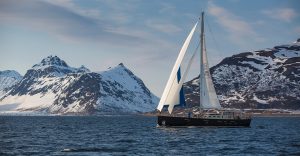18th June 2024 to 1st July 2024
Svalbard to Jan Mayen to Beerenberg Arctic Volcano Expedition
From £5230 per person
Deposit 25%. Balance due 12 weeks before departure
Climb Beerenberg, the northernmost active volcano in the world, on this 14-day expedition from Svalbard to Jan Mayen.
13 nights: 18 June– 1 July 2024
Price: 68,800 NOK/£5, 230 per person
Join us as we climb Beerenberg, the northernmost active volcano in the world, in this 14-day expedition. The voyage from Svalbard to Jan Mayen takes about 4-5 days. During this time, you will get to experience the open sea and the midnight sun. You will also have the opportunity to spot whales and other marine life.
This unique and challenging adventure is for experienced hikers who are in good physical condition and prepared for all types of weather conditions.
The hike to the summit of Beerenberg takes about 30 hours and involves crossing a glacier. The view from the top is incredible, but it's important to remember that this is an expedition and there is no guarantee that you will reach the top.
The expedition begins in Svalbard, where you'll board a sailboat and set sail for Jan Mayen. The voyage takes about 4-5 days and gives you a chance to experience the open sea and the midnight sun. You may also have the opportunity to spot whales and other marine life.
Upon arrival on Jan Mayen, you'll set up camp and begin preparations for the ascent of Beerenberg. After the descent, you'll have a few days to explore the island before sailing back to Svalbard.
Please note: This trip is a working passage and you are expected to take turns with the cooking, crewing, and cleaning of the boat throughout the trip.
Day 1: The trip start in Longyearbyen
We meet at the quay in Longyearbyen. Getting to know one another is the first step before discussing the week’s agenda. After getting to know the boat and equipment, we finish storing all the provisions and equipment onboard. Life on a boat requires cooperation, and we go through routines and procedures before departure. On this first evening, we leave the quay and cross Isfjorden.
Day 2 – 5: From Longyearbyen to Jan Mayen
This will be quite an ocean crossing from Svalbard to Jan Mayen. As soon as we get out into the open seas, we head straight for Jan Mayen. In good weather, we can arrive in less than four days, but if the weather is bad, it can take up to a day longer. In reality, the crossing is around 570 nautical miles, but the length of time we spend depends on wind direction and sea conditions.
Day 6: Landfall at the volcanic island, Jan-Mayen
Because of Jan-Mayen’s vulnerable and lonely location in the middle of the sea, it often experiences over 300 days of fog each year. It is possible that we won’t see the towering volcanic island until we are very close to it. As soon as we arrive in Jan-Mayen, we make a plan for disembarkation. With constant swells from the ocean, this alone can be challenging. We can anchor only in a few spots due to the conservation status of much of the island. Kvalrossbukta is one of the better harbors for this purpose, but if we have strong westerly winds we go to Båtvika. We choose the quietest side of the island and spend the hours it takes to get all goods, equipment, and people ashore. The first stage is done!
Day 7: “Basecamp Beerenberg”
Camp is set up on the beach, we get to know the island, and we plan our itinerary for the next few days. The weather is crucial in terms of all planning and we are prepared for all conditions. If we have a weather window on arrival, we set off towards the top immediately, but we may also end up waiting at camp for a few days. We distribute equipment between us, go through the route and techniques for glacier crossing, and get ready for the trip.
Day 8 – 9: Norway’s only active volcano
On Jan Mayen there are restrictions in relation to where it is allowed to establish a campsite, and we can only camp along the bays we anchor in. From here, the approach to the mountain is around 12-15 km, which will be the first stage of the trip to the top. Here we follow the military’s footsteps through the very special volcanic landscape where the feeling of being in one of the world’s most desolate wilderness almost becomes overwhelming! When the approach is completed, we start on Norway’s longest uphill trek. Up the glacier, we will eventually have to use our crampons, ice axes, and ropes, and tie ourselves into the ropes for safety on the last couple of hundred meters to the top. The goal is for everyone in the group to reach the top of Beerenberg. We have a number of days at our disposal and are optimistic. The hike out is as long as the hike in, and we will probably have some very long days to reach the summit.
Day 10: Backup day for Beerenberg
We will plan for an extra couple of days ashore on Jan Mayen to get a suitable weather window for our summit attempt. If we complete this feat early, we get an extra day or two of exploring the unique volcanic landscape on the island.
Day 11 – 14: We sail back to Svalbard
At this stage of the expedition we have learned to know each other well, and the boat will be a welcome home. We already know the routines and rhythm onboard, and will have a pleasant sail back to our starting point in Longyearbyen, Svalbard. Whether it is in high seas and strong winds, or on a flat Greenland Sea. Once we make landfall in Longyearbyen we celebrate a successful expedition with a good dinner on land. Thanks for the trip!
In Longyearbyen
We recommend everyone that is joining us on a trip to/from Longyearbyen to stay an extra day or two before traveling home/before the trip starts. Longyearbyen is a thriving little Arctic village, with raw arctic nature It’s always smart to add time for some rest and calmness before and after such a trip, to relax and let the impressions sink in.
The program
The program should be seen as a rough itinerary that we can adapt to the weather and conditions. We also reserve the right to change and improve our itineraries. We will have a dinghy for beach trips and small expeditions, fishing gear for cod, and gear to hike or make bonfires on the beach on all our trips – we are ready for adventure! Are you?
- Trip experience with a sailboat – experienced and locally familiar skipper/instructor on board
- Guide and expedition leader for the climb of Beerenberg
- Extra co-skipper/crew onboard
- Our Comfort Package consists of accommodation onboard in a shared double cabin (bunk or double bed) with a ready-made bed (warm and nice duvets and pillows!)
- All the food we eat during the trip, both onboard and on land at Jan-Mayen.
- Shared equipment for the basecamp (tent/stove) and shared glacier equipment.
- An environmentally friendly, local, sustainable, unique, exotic, and exclusive Norwegian adventure holiday.
- A shared experience and friendship with like-minded adventurers from around the world.
- A lot of time outdoors – raw and honest nature experiences.
- Use of our shared trip equipment: dinghy, kayaks, fishing equipment, etc.
- All boat-related expenses such as diesel, gas, harbor fees, etc.
- Personal safety equipment; Helly Hansen inflatable lifejacket
- Survival Suit and Search and Rescue insurance for everyone on board
- Teaching, advice, and guidance about boat life and sailing
- Travel to and from the start/end location
- Personal basecamp equipment (sleeping bag and mat), and personal glacier equipment (crampons, ice axe, harness)
- Optional meals at cafés/restaurants
- Personal snack for the days on land (so it’s smart to bring some extra snacks)
- Drinks like wine, beer, or high-exclusive apple juice and other luxuries (yes, we drink beer and wine on board, bring your own)
- Travel/cancellation insurance – optional, but recommended.
Vessel

70ft steel yacht designed to withstand tough arctic conditions, but with comfort and high standard along the way. The yacht sails very well, especially when it’s windy! There is a lot of space outside for sailing and staying on deck. Inside, the boat has ample space in the lounge and in the wheelhouse and a well-equipped galley. The boat has 6 cabins, most of them with private baths and showers.
Valiente is very well equipped for trips and expeditions including; a RIB light boat, two folding kayaks, big tanks for both water and diesel, a watermaker, generators, safety, and rescue equipment, communication equipment
Travel – in general
Sometimes we have to fly, but not always. If you have the luxury of time, we always encourage you to travel as environmentally friendly as possible. Traveling slowly also allows you to start your holiday in a special way. Cycling, taking the train, or driving a car together can be good options! Feel free to add some extra time before and after your trip, since up north the weather can be unpredictable and might affect your plans!
Travel Longyearbyen
The trip starts on Svalbard and ends in Isafjordur, Iceland.
A few rows to Svalbard, a few more sail, but most fly. Norwegian and SAS fly to Longyearbyen.
Travel Iceland
To and from Iceland there are many different routes. One option is the daily ferry route from Denmark via the Faroe Islands. There are also several daily departures and arrivals by plane from the Nordics, Europe, and America. If you want to sail more, you can join us on our further expeditions from Iceland, towards Scotland, Norway, Faroes, and Shetland!
Safety and risk – in general
We take safety seriously and on our trips, we train on handling different situations that can occur at sea. On board a boat and on trips, everyone must know what to do in potentially dangerous situations. For us, it is important that you as a guest and participant are trained quickly enough to be a participant – not a passenger. It contributes to learning, a sense of achievement, and increased safety for all. It’s also why our trips are considered to be sailing courses: you are trained to be one of the crew members on board. Feel free to contact us to discuss risk.
Safety and risk – expeditions
On our expedition trips, we often spend multiple days on sea-crossings, and we sail into areas far from people and with extra risk factors, such as sea ice and unreliable navigation charts. This requires our crew to have extra focus and awareness of the potential situations that might arise. We sail in these areas only in the most optimal seasons and use only our largest and most sturdy boats, which are both equipped and dimensioned to cope with this type of expedition sailing. We are fully aware that sailing is the safest and most accessible way to visit these very inaccessible places. However, sailing in general, and especially sailing in the Arctic and over the high seas, involves a certain risk that you must be willing to take. Feel free to contact us for a chat and guidance regarding risk.
Level of this trip
This is both a sailing expedition where we will undertake multi-day sea crossings, in addition to an expedition to reach the summit of Beerenberg. The part where we climb this volcano demands some prior experience with this type of long and tiring mountain climb and a good physical shape. The most challenging part of this trip is the length of the climb and the necessary endurance, but we also recommend that you have some prior experience with similar trips on glaciers and glacier crossings in rope-team.
You do not need to have sailed before to be on board, and we are joined by both people who have never sailed before and experienced sailors. If you are a beginner, we want to make you a seaman/woman as soon as possible, and if you are experienced, you will quickly get more responsibility and greater challenges. The group and crew will be divided into watch teams so that we can learn from each other and help each other out.
The boats we sail on our expeditions are large, robust, and sail well on the open seas. However, we do not control the weather, and we must be prepared for wind and potential heavy seas that we might encounter offshore. From light breezes to sailing in hard weather with several meters of swell, the proximity to the forces of nature on such an expedition is something most people find very unique and rewarding!
Equipment/packing
On this expedition, we provide shared equipment both for the basecamp and shared glacier equipment. This means tents, stoves, and cooking equipment for the basecamp, ropes, slings, prutzics, and protection- and rescue equipment for the glacier. Everybody has to provide standard mountain equipment themselves including a sleeping bag/-mat, in addition to personal glacier equipment; crampons, ice-ax, helmet, and harness.
Else is it as with all activities, plenty of specialized equipment and clothing for sailing. We do not expect you to buy lots of new equipment to join any of our trips, so, use what you have, borrow what you need from a friend, try to purchase used equipment, and if you have to invest in new equipment – buy quality items that will last. What you need is something waterproof and windproof on the outside, and layered clothing underneath. A pair of higher rubber boots for landings from the dinghy is very nice to have, in addition to slippers to wear below deck. Out on the high seas and in the Arctic, it is cold even in summer, so bring both swimwear and plenty of warm clothes. We will send you a detailed recommended packing list in good time before departure.
Food and cooking
On our trips, you will be part of the crew onboard and get the chance to participate in all aspects of the running of the sailboat. This includes the cooking, where everyone is taking turns in the galley! Skippers and guides assist as much as they can along the way. Before the trip, we set up a menu and purchase what is needed. We offer good menus with healthy “boat-friendly” food. If you have allergies or preferences, let us know in the registration form and we will take that into account. During the trip, we often sail by a good restaurant or two where we stop and eat.
What we expect from you
We want you to take part in the routines onboard the sailboat, whether it is sailing, docking, navigating, looking for whales and icebergs, washing up, cooking, cleaning the boat, or contributing in other ways when required. You will be split into a watch team, with the teams working in rotations of 4 hours on and 8 hours off, with a rotating system to make sure that the night shifts are divided equally among all watch teams. Our trips require a little work from the participants – and you must be open to contributing and open up a bit socially. We have many different people with us on our trips, and most people get along very well. Our experience is that doing things with others out in nature, and not least doing things with new people with different personalities than one might be used to, is what creates the best, most interesting, and memorable stories :)
Life on board and accommodation
Life on board a sailboat is social and pleasant, but for some, it can be perceived as quite intimate and crowded, which one should be prepared for. On our trips, everyone participates in the operation of the sailboat and everyone is considered a crew. We would like to get to know you well and hope that you will get to know everyone else on the boat as soon as possible. It requires some patience, generosity, and an open mind to thrive, but the new acquaintances and completely raw nature experiences will take your focus as soon as you become comfortable with life at sea.
Accommodation on the boat is part of the fun. The accommodation is generally in shared cabins, some of which have a double bed and some of which have bunk beds. Figuring out who sleeps where can be a bit of a puzzle, but we do believe we’ve gotten quite good at it. Let us know if you have any special needs or reservations.
We have plenty of heating and good food on the boat, but not always an abundance of fresh water. This means it will not be possible to shower every day, but more or less every other day we are either in a harbor with fresh water or we sail through a place where we can borrow showers or enjoy a sauna. A morning swim in the sea is free and is available all year round!
What kind of people join this trip – and how many are we on board?
Many come alone, some travel as couples, and others travel as a group of friends. The common denominator for everyone is that these are fun and interesting people you will become friends with almost no matter what. Sharing grand experiences creates strong ties! Many people wonder about the age composition of our trips, but this isn’t so important to us. It doesn’t matter if you are young or old as long as you want to go on a trip and intend to do your part in making this a great trip for everyone. Most of our participants are usually between 25-55 years old. The number of participants varies from trip to trip, but on these trips, we are usually between 6 and 11 people.
Environment and sustainability
In general, sailing is an environmentally friendly activity, and we sail as much as we can and use the engine as little as possible. We encourage crew and participants to travel as environmentally friendly as possible, and we use local ingredients and resources as much as we can. We also run trips where we collect litter and clean ocean trash from beaches.
Philosophically, we often say that sailing is an exercise in sustainability: we move with the wind and we have limitations on things like water, diesel, electricity, and food. In order to run sustainably, knowledge, patience, flexibility, and hard work are required. The same can be said about many other things that one tries to do in a sustainable way.
Special conditions
Conditions when it comes to the climb of Beerenberg: Occasionally we might not get the chance to reach the top of Beerenberg because of factors like injuries/weather/others. We have a high focus on safety while we are underway. Participation is at your own risk. No reimbursement will apply if we cannot reach the summit as a result of unforeseen events, such as injuries/weather or other conditions. However, we have almost a full week available on this volcanic island and we will play around in the area rich in nature and opportunities for alternative activities.
Fly into Longyearbyen, Svalbard. Please refer to “Other Practical Information” for more details.
Depart from Longyearbyen, Svalbard. Please refer to “Other Practical Information” for more details.
Please note: This trip is a working passage and you are expected to take turns with the cooking, crewing, and cleaning of the boat throughout the trip.
Day 1: The trip start in Longyearbyen
We meet at the quay in Longyearbyen. Getting to know one another is the first step before discussing the week’s agenda. After getting to know the boat and equipment, we finish storing all the provisions and equipment onboard. Life on a boat requires cooperation, and we go through routines and procedures before departure. On this first evening, we leave the quay and cross Isfjorden.
Day 2 – 5: From Longyearbyen to Jan Mayen
This will be quite an ocean crossing from Svalbard to Jan Mayen. As soon as we get out into the open seas, we head straight for Jan Mayen. In good weather, we can arrive in less than four days, but if the weather is bad, it can take up to a day longer. In reality, the crossing is around 570 nautical miles, but the length of time we spend depends on wind direction and sea conditions.
Day 6: Landfall at the volcanic island, Jan-Mayen
Because of Jan-Mayen’s vulnerable and lonely location in the middle of the sea, it often experiences over 300 days of fog each year. It is possible that we won’t see the towering volcanic island until we are very close to it. As soon as we arrive in Jan-Mayen, we make a plan for disembarkation. With constant swells from the ocean, this alone can be challenging. We can anchor only in a few spots due to the conservation status of much of the island. Kvalrossbukta is one of the better harbors for this purpose, but if we have strong westerly winds we go to Båtvika. We choose the quietest side of the island and spend the hours it takes to get all goods, equipment, and people ashore. The first stage is done!
Day 7: “Basecamp Beerenberg”
Camp is set up on the beach, we get to know the island, and we plan our itinerary for the next few days. The weather is crucial in terms of all planning and we are prepared for all conditions. If we have a weather window on arrival, we set off towards the top immediately, but we may also end up waiting at camp for a few days. We distribute equipment between us, go through the route and techniques for glacier crossing, and get ready for the trip.
Day 8 – 9: Norway’s only active volcano
On Jan Mayen there are restrictions in relation to where it is allowed to establish a campsite, and we can only camp along the bays we anchor in. From here, the approach to the mountain is around 12-15 km, which will be the first stage of the trip to the top. Here we follow the military’s footsteps through the very special volcanic landscape where the feeling of being in one of the world’s most desolate wilderness almost becomes overwhelming! When the approach is completed, we start on Norway’s longest uphill trek. Up the glacier, we will eventually have to use our crampons, ice axes, and ropes, and tie ourselves into the ropes for safety on the last couple of hundred meters to the top. The goal is for everyone in the group to reach the top of Beerenberg. We have a number of days at our disposal and are optimistic. The hike out is as long as the hike in, and we will probably have some very long days to reach the summit.
Day 10: Backup day for Beerenberg
We will plan for an extra couple of days ashore on Jan Mayen to get a suitable weather window for our summit attempt. If we complete this feat early, we get an extra day or two of exploring the unique volcanic landscape on the island.
Day 11 – 14: We sail back to Svalbard
At this stage of the expedition we have learned to know each other well, and the boat will be a welcome home. We already know the routines and rhythm onboard, and will have a pleasant sail back to our starting point in Longyearbyen, Svalbard. Whether it is in high seas and strong winds, or on a flat Greenland Sea. Once we make landfall in Longyearbyen we celebrate a successful expedition with a good dinner on land. Thanks for the trip!
In Longyearbyen
We recommend everyone that is joining us on a trip to/from Longyearbyen to stay an extra day or two before traveling home/before the trip starts. Longyearbyen is a thriving little Arctic village, with raw arctic nature It’s always smart to add time for some rest and calmness before and after such a trip, to relax and let the impressions sink in.
The program
The program should be seen as a rough itinerary that we can adapt to the weather and conditions. We also reserve the right to change and improve our itineraries. We will have a dinghy for beach trips and small expeditions, fishing gear for cod, and gear to hike or make bonfires on the beach on all our trips – we are ready for adventure! Are you?
Base layer – 2x warm thermal tops + thermal leggings
Mid layer – 2x fleece type mid layers + mid layer trousers
Light waterproof shell (waterproof hiking type jacket and trousers) – for exploring ashore
Down jacket – a down (or synthetic alternative) jacket, the warmer the better
Gillet – optional but a really versatile mid layer, down or synthetic down are great
Hats – 2x warm wool hats, ear flaps are great
Waterproof hat – a waterproof hat or cap (eg Sealskins)
Neck warmer – 2x ‘Buff’ style neck warmers
Gloves – one waterproof pair (ski or fishing type) + 2x thinner fleece liner / spare pairs
Socks – 2x pairs of warm socks for sailing + hiking socks for exploring ashore
Boots – Wellington type boots. These are needed not just for sailing but also for getting ashore from the rib where you may need to stop into mid-calf depth water. They don’t need to be expensive or sailing specific, but they should be waterproof with good grip
Hiking shoes / boots – suitable for exploring on rough or wet terrain ashore
Rucsac – for on land exploring
Underwear – a couple of sets of comfortable underwear
Swimwear – you might not fancy a dip in the Arctic waters but a local hot tub can be a treat that you don’t want to miss out on
Camera, batteries, memory cards etc – it is possible to charge camera batteries onboard but it is a good idea to bring spare batteries and lots of memory card space
Entertainment – books, music etc for rest time
Toiletries – basic wash kit with travel-sized bottles
Eye mask and earplugs – can make sleeping easier in the midnight sun
Any personal medications that you need – ensure you have enough to last the whole trip
Dry bags – recommended for keeping any electrical kit in and for taking things ashore
Head torch – ideally with a red light function
Sunscreen – 24hr daylight can be relentless
Sunglasses
A set of ‘shore clothes’ for travelling in / rest days in town
Passport / visas
Credit/debit card for shore-based activities or travel emergencies
Kitbag – this must be squashy type (not a suitcase) a large barrel type bag is ideal

















